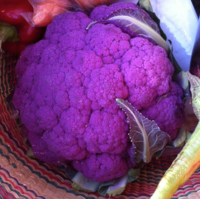
Photo from wikipedia
The present study characterized a genetically and phenotypically diverse collection of 27 purple and two non-purple (one orange and one yellow) carrot accessions for concentration of root anthocyanins, phenolics, and… Click to show full abstract
The present study characterized a genetically and phenotypically diverse collection of 27 purple and two non-purple (one orange and one yellow) carrot accessions for concentration of root anthocyanins, phenolics, and carotenoids, and antioxidant capacity estimated by four different methods (ORAC, DPPH, ABTS, FRAP), in a partially replicated experimental design comprising data from two growing seasons (2018 and 2019). Broad and significant (p < 0.0001) variation was found among the accessions for all the traits. Acylated anthocyanins (AA) predominated over non-acylated anthocyanins (NAA) in all the accessions and years analyzed, with AA accounting for 55.5–100% of the total anthocyanin content (TAC). Anthocyanins acylated with ferulic acid and coumaric acid were the most abundant carrot anthocyanins. In general, black or solid purple carrots had the greatest TAC and total phenolic content (TPC), and the strongest antioxidant capacities, measured by all methods. Antioxidant capacity, estimated by all methods, was significantly, positively, and moderately-to-strongly correlated with the content of all individual anthocyanins pigments, TAC, and TPC, in both years (r = 0.59–0.90, p < 0.0001), but not with the carotenoid pigments lutein and β-carotene; suggesting that anthocyanins and other phenolics, but not carotenoids, are major contributors of the antioxidant capacity in purple carrots. We identified accessions with high concentration of chemically stable AA, with potential value for the production of food dyes, and accessions with relatively high content of bioavailable NAA that can be selected for increased nutraceutical value (e.g., for fresh consumption).
Journal Title: Plants
Year Published: 2023
Link to full text (if available)
Share on Social Media: Sign Up to like & get
recommendations!